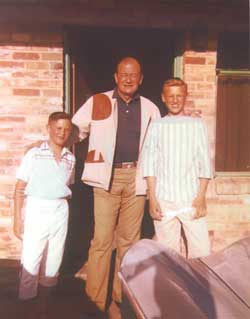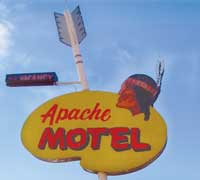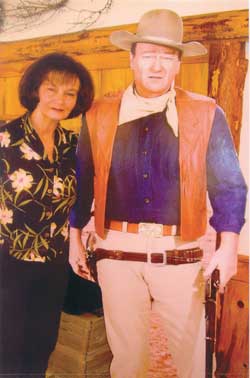
Carl Rappe (left), actor John Wayne, and Dave Sakrison at the Apache Motel. Photo courtesy of Mark Wright |
One of the first motels built in Moab, the Apache Motel made it to the National Register of Historic Places this year, largely due to its connection to Hollywood and a booming population of uranium prospectors, but also because of its unique architecture in the Atomic Era.
Actor John Wayne -- an icon of films in the 1950s and ‘60s -- played a major role in making the motel eligible for the prestigious listing, just as he played major roles in Westerns and military movies of that era. Ironically, the actor succumbed in June of 1979 to lung cancer, his death commonly attributed to exposure to radioactive fallout in the aftermath of Atomic bomb testing in Nevada that contaminated the air in southwestern Utah during filming near Kanab.
“It was when John Wayne was making movies...and everyone on that movie set died of a shortened life or cancer,” said Ralph Smith, current owner of the Apache Motel. “Everyone believed that they were exposed to the radiation. He was in the line of the fallout.”
The passing of “the Duke” (whose real name was Marion Michael Morrison), was particularly evocative for Smith, not just because of the actor’s connection to Moab as a place that Smith loves like he loved Disneyland as a boy, but also because, coincidentally, Smith has a friend who is among the “Atomic vets” who suffered ill effects or death from radiation exposure. An attorney, Smith helped represent a group of World War II and Korean War vets in a lawsuit against the government in the 1990s who testified that they had been literally commanded to march within a mile of a nuclear explosion site and were being denied adequate legal, retirement and disability benefits.
“They wanted to show that the government wasn’t telling the truth,” Smith said.
A native and current resident of southern California, Smith had competed in 13 Boston Marathon races by the time he made his way to Moab in 2003 to run the renowned Half-Marathon on Highway 128. “I’d heard about Moab and I came and I just loved it. I felt like this was like the Grand Canyon and Disneyland.”
Asking around, he soon learned that the two-story motel, at 166 S. 400 East, was for sale. Smith became a first-time motel owner.
 According to the registration form submitted by the U.S. Department of the Interior’s National Park Service, the Apache Motel In the 1950s was the only commercial structure in the Second South residential neighborhood area, which at that time bordered the main traffic artery into Moab from the highway (now U.S. Highway 191). State Highway 160 ran along the current 400 East northward to Center Street, then directed traffic left and westward to Main Street. The certificate of eligibility for nomination states that the motel has the best historic integrity of the early motels built during the “period of significance from 1954 to 1958,” despite minor alterations to the roof line and some exterior and interior modifications, and that the rooms have not changed much since the 1950s. According to the registration form submitted by the U.S. Department of the Interior’s National Park Service, the Apache Motel In the 1950s was the only commercial structure in the Second South residential neighborhood area, which at that time bordered the main traffic artery into Moab from the highway (now U.S. Highway 191). State Highway 160 ran along the current 400 East northward to Center Street, then directed traffic left and westward to Main Street. The certificate of eligibility for nomination states that the motel has the best historic integrity of the early motels built during the “period of significance from 1954 to 1958,” despite minor alterations to the roof line and some exterior and interior modifications, and that the rooms have not changed much since the 1950s.
The National Register form states that the motel opened in April 1955, and a swimming pool was added a few months later.
The document classifies the 33-unit brick structure as a “Victorian eclectic, bungalow” style, from the late-19th and early-20th century Modern American movements, and describes the architecture as representative of “the transition between the pre-1950s motor courts and the emergence of the motor inn in the 1950s.”
The motel’s iconic sign -- a facial profile of an American Indian wearing a headband, mounted on a 20-foot-high pole shaped like a giant arrow with a feathered tip -- is also representative of the significant historic period in Moab when, according to the document, dramatic changes occurred because of two unrelated events: “The first motion picture to be filmed in the area (1949) and the discovery of uranium (1952).”
When John Wayne came to town in 1950 for filming of Rio Grande, with actress Maureen O’Hara, the local newspaper reported that cast and crew “completely took over Moab’s one motel and three auto-tourist camps,” while others stayed in private homes or a tent city, according to researcher Korral Brochinsky. The Uranium Boom was yet to explode, and many residents were experiencing hard times. Jean Burr remembers that her great-grandmother, Irene Powell, had to sell her house in 1953 for $150 she owed in taxes, and in June 1954 the Alexander Investment Company announced plans to build a $50,000 motel where the house stood.
“I remember before it was there,” Burr said. “There was this old two-story house -- my great-grandmother’s -- and I used to play in it. I thought it was a mansion.” Burr’s grandmother, Liza Burr, owned property behind the motel, and that’s where her father and mother lived for decades, in a mobile home next to the motel. She suspects the company that bought the Powell property named the motel after the movie Fort Apache (1949), while the register form suggests it may have been named after the Apache Uranium Company or the movie Battle At Apache Pass (1952).
“It was fun when the movies came to Moab,” Burr said. “John Wayne? Oh my heck, he’s still my idol. He was nice to us kids and he impressed me. I looked to my dad as a John Wayne type. He treated you very nice.”

Barbara Brady, Apache Motel manager, with life-size cut-out of John Wayne, in motel lobby.
Photo by Vicki Barker. |
Barbara Brady, Apache Motel manager for 21 years, said she’s met very few people who met John Wayne who didn’t like him, and heard about his love for children. He would stay at the motel with his family on vacation, as well as during filming.
“You can’t imagine the amount of people around the world who are just mesmerized that John Wayne stayed here,” Brady said. “He’s an icon; he’s an idea, I think -- not that he was always right in his movies -- but he was totally honest. They think of him as being ‘a man’s man,’ because he stated the truth; because of his respectability.”
The motel’s owner is thrilled with the listing on the register, which the federal agency ruled as eligible Feb. 19 and the Utah State Historic Preservation Office officially announced March 6, 2008. Smith credits Brady with nudging him to have the motel nominated, and he puts the uranium and movie industries -- and John Wayne in particular -- at the top of the list of credits for the successful listing.
“We’re trying to make this a really nice place in honor of him,” Smith said.
“In the World Wars I and II, Americans were looked upon as heroes, and John Wayne was representative of those who liberated Europe,” Smith added. “He was in the Service, and made many, many war movies -- that was a romantic idea, of John Wayne coming to rescue you -- the cowboy, quiet and shy around girls but carrying a big stick. To Europeans, he was the gold standard of the American West and American living.”
Brady said people call all the time to inquire about the room John Wayne stayed in, so she created the “John Wayne Suite” upstairs -- a big, two-room unit that Wayne occupied when he brought family to Moab. While research proceeded on the nomination, the motel began upgrading furnishings and replaced the handrail to bring it up to code. The process took about two years, Smith said. Next, a new directional sign will be erected on Highway 191 referring to the “historic” motel and will eventually sport a three-dimensional image of John Wayne. And Smith wants to create a shady picnic area behind the motel in hopes of catering to family reunions.
In her quest to draw more visitors to lodging off the beaten path, Brady also got help from the Moab Film Commission to create a Western-film gallery in the motel lobby, lining the walls with images of actors and scenes from movies produced in Moab, Monument Valley and other areas in southeastern Utah. An odd item on a shelf that never fails to elicit chuckles and reflects the humor of “the Duke” is a roll labeled John Wayne Toilet Paper that Brady bought somewhere. It reads: “It’s rough, it’s tough, and it won’t take crap off anyone.”
“We had a guy stay here off and on for three weeks -- a Russian. He said, ‘That could pass for Russian toilet paper.’ Well, that’s more than I wanted to hear,” Brady said, laughing.
The motel has hosted 15 movie stars over the years, and even Moab’s own “Mayor Dave” Sakrison as a boy. He and a buddy, Carl Rappe (and Carl’s cousin Mark Wright) got brave one day and knocked on the door of John Wayne’s room. Rappe remembers Wayne yelling out to them to go away. They ran down the stairs and hid behind an outbuilding in back, then worked up their courage and went back up, knocking again. This time, the actor stepped out amiably, greeted the boys, and had his picture taken with them.
“It was a special moment kind of thing,” Rappe said.
Mostly film crews have stayed at the Apache since the days of John Wayne, Brady said. The most memorable for her was the crew of Thelma and Louise, who filled the motel for weeks in the peak of summer in 1991. It wasn’t just the heat that summer that nearly gave Brady a heart attack. “The crew pulled a trick on me,” she said.
They had an emergency vehicle that was kept onsite during filming, and late one night while Brady stood at the front desk taking a phone reservation, a couple of the crew turned on the flashing lights and siren and rushed straight at the large picture window of the lobby, “like they’re coming through the front window.” She gasped and started screaming on the telephone, and the guest was shouting back, asking if she was allright. “Then they throw open the door and say, like nothing happened: ‘Honey, I’m home!’”
While Brady and the Apache’s owner never met John Wayne, “the ghost is still supposed to be there,” Smith said. “People supposedly hear it at night.” He laughed. “Maybe it’s Pilar (Wayne’s wife) yelling at him. For as strong a person as he was...I’m sure he just asked: ‘How high and where?’” |

 According to the registration form submitted by the U.S. Department of the Interior’s National Park Service, the Apache Motel In the 1950s was the only commercial structure in the Second South residential neighborhood area, which at that time bordered the main traffic artery into Moab from the highway (now U.S. Highway 191). State Highway 160 ran along the current 400 East northward to Center Street, then directed traffic left and westward to Main Street. The certificate of eligibility for nomination states that the motel has the best historic integrity of the early motels built during the “period of significance from 1954 to 1958,” despite minor alterations to the roof line and some exterior and interior modifications, and that the rooms have not changed much since the 1950s.
According to the registration form submitted by the U.S. Department of the Interior’s National Park Service, the Apache Motel In the 1950s was the only commercial structure in the Second South residential neighborhood area, which at that time bordered the main traffic artery into Moab from the highway (now U.S. Highway 191). State Highway 160 ran along the current 400 East northward to Center Street, then directed traffic left and westward to Main Street. The certificate of eligibility for nomination states that the motel has the best historic integrity of the early motels built during the “period of significance from 1954 to 1958,” despite minor alterations to the roof line and some exterior and interior modifications, and that the rooms have not changed much since the 1950s.